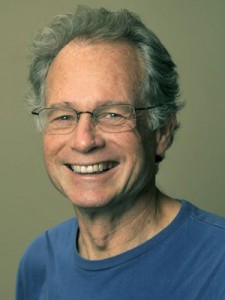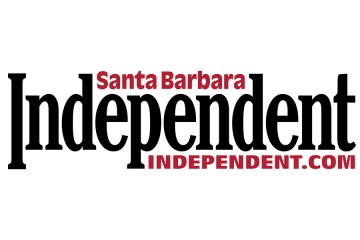UCSB’s Harder Stadium is rightfully called “Soccer Heaven,” where Gaucho soccer teams have set NCAA attendance records and won the 2006 national championship. But this weekend, aging men who blocked and tackled and ran and passed and caught footballs for the Gauchos will visit the campus and celebrate the 55 seasons that their sturdy breed roamed the turf.
1921-41: BIRTH OF THE GAUCHOS
Santa Barbara State Teachers College fielded its first football team in 1921. The Roadrunners, as they were called, played their home games on a dirt field at Pershing Park.
.
John Zant’s column appears
each week in the
Santa Barbara Independent
The program gained some stature in 1934 when Theodore “Spud” Harder, who had played for the legendary Glenn “Pop” Warner at Stanford, became head coach. In 1936, Harder urged the adoption of a new mascot, declaring the spindly-legged roadrunner was unsuitable. Gauchos won out in a student vote, led by coeds who were enamored of the Douglas Fairbanks movie The Gaucho.
The freshly minted Gauchos put together the best football record in school history, 9-1, in the 1936 season. Their standouts included running backs Bob Morelli and Howard Yeager, and linemen Don Hart and Doug Oldershaw. In 1937, Yeager was caught speeding on State Street. Rather than impose a fine, the judge ordered him to score two touchdowns in the upcoming game against Redlands. He scored three. Yeager and Oldershaw later played for the New York Giants.
La Playa Stadium, now home of the SBCC Vaqueros, was originally built for the State College by the Works Progress Administration. The Gauchos made their debut in the seaside stadium on October 15, 1938. It was a scenic success, but they lost by a score of 6-3 to Willamette University from Oregon.
The third home of the Gauchos would become the stadium built on the campus in 1966. It is named Harder Stadium in honor of their first winning football coach.
1946-62: POSTWAR BOOMLET
Veterans filled the roster of the Gaucho football team when it resumed playing after the war. Among them was 1949 graduate Sam Cathcart, a rugged halfback who later played for the San Francisco 49ers. Cathcart returned to coach the Santa Barbara High Dons, and many other UCSB football standouts in the ’50s and ’60s became first-rate coaches: Dave Gorrie (UCSB), Mike Moropoulos (SBHS), Sut Puailoa (San Marcos), Ray Schaack (Dos Pueblos and SBCC), Jim St. Clair (Dos Pueblos), John Stoney (San Marcos), and Dick Mires (Dos Pueblos).
Stan Williamson, an All-America center on USC’s 1931 national championship team, coached the Gauchos for eight seasons after the war. He was followed by Ed Cody, a former fullback for the Green Bay Packers and Chicago Bears, who spent four seasons at UCSB before leaving to coach in the NFL.
Fidenzio “Bruno” Brunello set a single-game rushing record (217 yards) during the Cody era in 1956. Johnny Morris, a 5’10” speedster who was recruited to run track, emerged as an outstanding flanker. In those days, the Gauchos played UC Davis at the L.A. Coliseum as a prelude to the UCLA-Cal game. Morris made such an impression in UCSB’s 39-0 victory over the Aggies that the Chicago Bears drafted him in 1958. He played 10 years for the Bears and is still their career leader in receiving yardage (5,059).
1963-71: CAMELLIA BOWL TO BIG TIME
“Cactus Jack” Curtice, who had a storied career as head football coach at West Texas A&M, UTEP, Utah (where he earned the title “Mr. Forward Pass”), and Stanford, took over as coach of the Gauchos in 1963. He led the Gauchos to their finest season in the modern era in 1965. Their 8-1 regular season included thrilling victories over Santa Clara (14-13) and Hawai‘i (3-0 on a field soaked by a monsoon). They advanced to the Camellia Bowl in Sacramento, where L.A. State claimed the college division championship in a hard-fought 18-10 victory over the Gauchos.
The entire Camellia Bowl team, celebrating its 50th anniversary this weekend, is in the UCSB Athletic Hall of Fame: Jim Barber, Corky Barrett, Gary Bianchini, Bob Blindbury, Dick Booth, John Boyle, Dick Burrill, Gary Cline, Bob Cordero, Jim Coward, Steve Ford, Jason Franci, Tony Goehring, Mel Gregory, Doug Hayes, Greg Heer, Preston Hensley, Bob Heys, Bruce Hitchcock, Mike Hitchman, George Jenkins, John Keever, Dick Kezirian, Allan LaRoche, Ted Maneki, Al Martens, Ron Moser, Fred Oppezzo, Jim Orear, Mike Patitucci, Jack Smith, Larry Swarbrick, Mike Thomas, Paul Vallerga, Jim Wankum, Bart Weitzenberg, Scott Williams, and Ernie Zomalt.
Harder Stadium opened with a 64-3 Gaucho victory over Cal Western in November of 1966. At Curtice’s invitation, Vince Lombardi brought the Green Bay Packers to practice on the field before their Super Bowl I victory in 1967. Curtice hoped the stadium would become a home of big-time football when he retired as coach in 1970 and turned the Gauchos over to his capable assistant, Andy Everest. But social currents and the economics of the sport dictated otherwise. UCSB suffered lopsided road defeats to Washington (65-7) and Tennessee (48-7) at the start of the 1971 season, and flagging home attendance signaled the death knell of the program.
1983-91: REVIVAL AND REPEAL
UCSB students Brad Tisdale and Gary Rhodes spearheaded a movement to bring intercollegiate football back to the school. They got a club team going, and in the 1985 student election, a referendum was passed to fund a non-scholarship, Division III football program. Former Gaucho linebacker Mike Warren, a successful coach at Lompoc High, took over as head coach.
From 1987-1991, the Gauchos went 33-15 under Warren and his successor, Rick Candaele. They beat Cal Lutheran five times. They were 3-1 against San Diego and 4-1 against Azusa Pacific, a top NAIA school. But in 1992, the NCAA legislated that Division I colleges (as UCSB was in other sports) must play at the Division I level in all sports. That leap would have required a huge increase in the expense of the program, and once again UCSB dropped football.
John Barnes, the Gauchos’ last quarterback, provided a glorious epilogue. He walked on at UCLA, and an improbable spate of injuries made him the starting QB in the Bruins’ 1992 game against USC. Barnes passed for 385 yards and three touchdowns, rallying UCLA to a legendary 38-37 upset of the Trojans.



Nobody chronicles Santa Barbara sports history like John Zant. That was outstanding!